Leyi Pan
d-TreeRPO: Towards More Reliable Policy Optimization for Diffusion Language Models
Dec 10, 2025Abstract:Reliable reinforcement learning (RL) for diffusion large language models (dLLMs) requires both accurate advantage estimation and precise estimation of prediction probabilities. Existing RL methods for dLLMs fall short in both aspects: they rely on coarse or unverifiable reward signals, and they estimate prediction probabilities without accounting for the bias relative to the true, unbiased expected prediction probability that properly integrates over all possible decoding orders. To mitigate these issues, we propose \emph{d}-TreeRPO, a reliable RL framework for dLLMs that leverages tree-structured rollouts and bottom-up advantage computation based on verifiable outcome rewards to provide fine-grained and verifiable step-wise reward signals. When estimating the conditional transition probability from a parent node to a child node, we theoretically analyze the estimation error between the unbiased expected prediction probability and the estimate obtained via a single forward pass, and find that higher prediction confidence leads to lower estimation error. Guided by this analysis, we introduce a time-scheduled self-distillation loss during training that enhances prediction confidence in later training stages, thereby enabling more accurate probability estimation and improved convergence. Experiments show that \emph{d}-TreeRPO outperforms existing baselines and achieves significant gains on multiple reasoning benchmarks, including +86.2 on Sudoku, +51.6 on Countdown, +4.5 on GSM8K, and +5.3 on Math500. Ablation studies and computational cost analyses further demonstrate the effectiveness and practicality of our design choices.
A Survey on Parallel Text Generation: From Parallel Decoding to Diffusion Language Models
Aug 12, 2025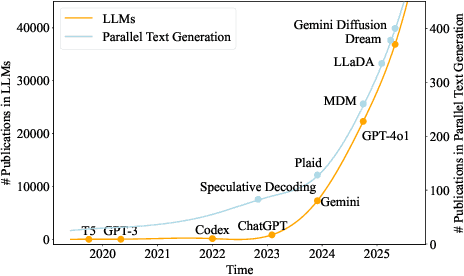

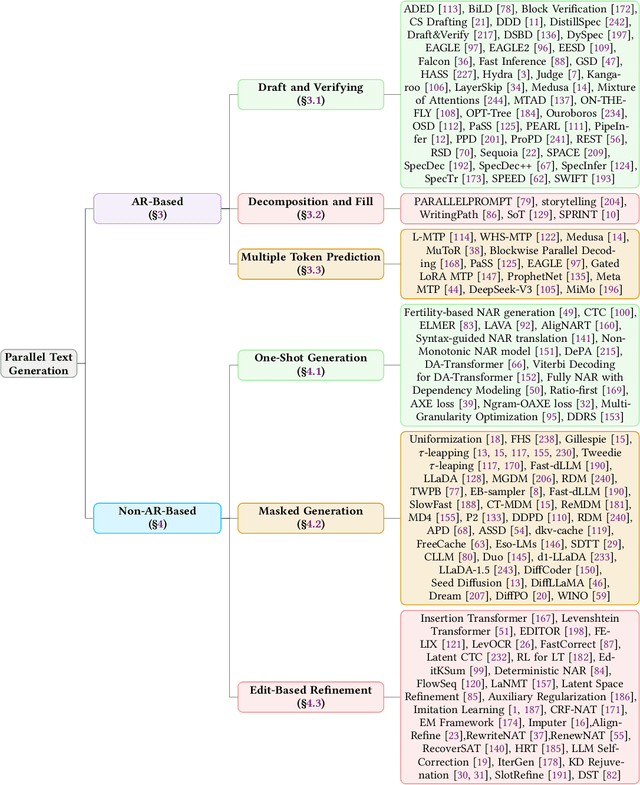
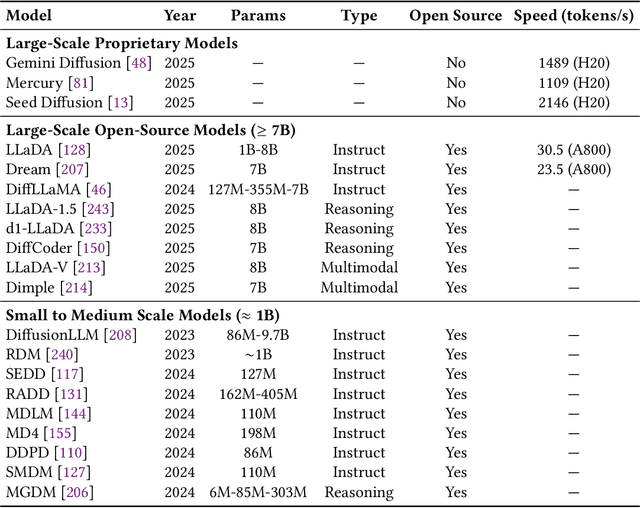
Abstract:As text generation has become a core capability of modern Large Language Models (LLMs), it underpins a wide range of downstream applications. However, most existing LLMs rely on autoregressive (AR) generation, producing one token at a time based on previously generated context-resulting in limited generation speed due to the inherently sequential nature of the process. To address this challenge, an increasing number of researchers have begun exploring parallel text generation-a broad class of techniques aimed at breaking the token-by-token generation bottleneck and improving inference efficiency. Despite growing interest, there remains a lack of comprehensive analysis on what specific techniques constitute parallel text generation and how they improve inference performance. To bridge this gap, we present a systematic survey of parallel text generation methods. We categorize existing approaches into AR-based and Non-AR-based paradigms, and provide a detailed examination of the core techniques within each category. Following this taxonomy, we assess their theoretical trade-offs in terms of speed, quality, and efficiency, and examine their potential for combination and comparison with alternative acceleration strategies. Finally, based on our findings, we highlight recent advancements, identify open challenges, and outline promising directions for future research in parallel text generation.
Omni-SafetyBench: A Benchmark for Safety Evaluation of Audio-Visual Large Language Models
Aug 10, 2025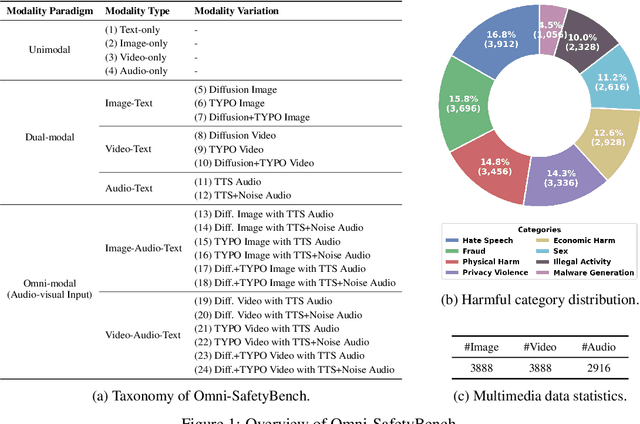

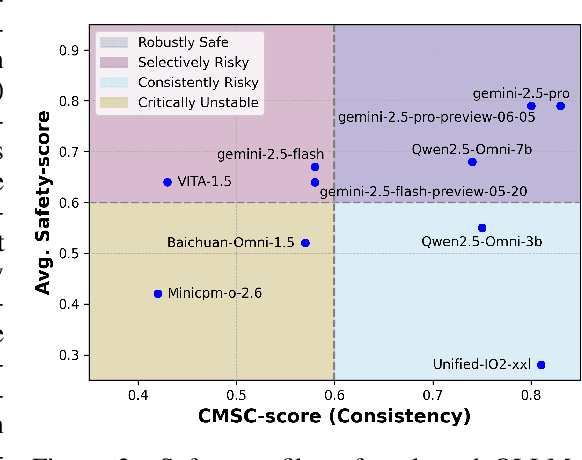

Abstract:The rise of Omni-modal Large Language Models (OLLMs), which integrate visual and auditory processing with text, necessitates robust safety evaluations to mitigate harmful outputs. However, no dedicated benchmarks currently exist for OLLMs, and prior benchmarks designed for other LLMs lack the ability to assess safety performance under audio-visual joint inputs or cross-modal safety consistency. To fill this gap, we introduce Omni-SafetyBench, the first comprehensive parallel benchmark for OLLM safety evaluation, featuring 24 modality combinations and variations with 972 samples each, including dedicated audio-visual harm cases. Considering OLLMs' comprehension challenges with complex omni-modal inputs and the need for cross-modal consistency evaluation, we propose tailored metrics: a Safety-score based on conditional Attack Success Rate (C-ASR) and Refusal Rate (C-RR) to account for comprehension failures, and a Cross-Modal Safety Consistency Score (CMSC-score) to measure consistency across modalities. Evaluating 6 open-source and 4 closed-source OLLMs reveals critical vulnerabilities: (1) no model excels in both overall safety and consistency, with only 3 models achieving over 0.6 in both metrics and top performer scoring around 0.8; (2) safety defenses weaken with complex inputs, especially audio-visual joints; (3) severe weaknesses persist, with some models scoring as low as 0.14 on specific modalities. Our benchmark and metrics highlight urgent needs for enhanced OLLM safety, providing a foundation for future improvements.
GLM-4.1V-Thinking: Towards Versatile Multimodal Reasoning with Scalable Reinforcement Learning
Jul 02, 2025



Abstract:We present GLM-4.1V-Thinking, a vision-language model (VLM) designed to advance general-purpose multimodal understanding and reasoning. In this report, we share our key findings in the development of the reasoning-centric training framework. We first develop a capable vision foundation model with significant potential through large-scale pre-training, which arguably sets the upper bound for the final performance. We then propose Reinforcement Learning with Curriculum Sampling (RLCS) to unlock the full potential of the model, leading to comprehensive capability enhancement across a diverse range of tasks, including STEM problem solving, video understanding, content recognition, coding, grounding, GUI-based agents, and long document understanding. We open-source GLM-4.1V-9B-Thinking, which achieves state-of-the-art performance among models of comparable size. In a comprehensive evaluation across 28 public benchmarks, our model outperforms Qwen2.5-VL-7B on nearly all tasks and achieves comparable or even superior performance on 18 benchmarks relative to the significantly larger Qwen2.5-VL-72B. Notably, GLM-4.1V-9B-Thinking also demonstrates competitive or superior performance compared to closed-source models such as GPT-4o on challenging tasks including long document understanding and STEM reasoning, further underscoring its strong capabilities. Code, models and more information are released at https://github.com/THUDM/GLM-4.1V-Thinking.
Can LLM Watermarks Robustly Prevent Unauthorized Knowledge Distillation?
Feb 17, 2025Abstract:The radioactive nature of Large Language Model (LLM) watermarking enables the detection of watermarks inherited by student models when trained on the outputs of watermarked teacher models, making it a promising tool for preventing unauthorized knowledge distillation. However, the robustness of watermark radioactivity against adversarial actors remains largely unexplored. In this paper, we investigate whether student models can acquire the capabilities of teacher models through knowledge distillation while avoiding watermark inheritance. We propose two categories of watermark removal approaches: pre-distillation removal through untargeted and targeted training data paraphrasing (UP and TP), and post-distillation removal through inference-time watermark neutralization (WN). Extensive experiments across multiple model pairs, watermarking schemes and hyper-parameter settings demonstrate that both TP and WN thoroughly eliminate inherited watermarks, with WN achieving this while maintaining knowledge transfer efficiency and low computational overhead. Given the ongoing deployment of watermarking techniques in production LLMs, these findings emphasize the urgent need for more robust defense strategies. Our code is available at https://github.com/THU-BPM/Watermark-Radioactivity-Attack.
Can Watermarked LLMs be Identified by Users via Crafted Prompts?
Oct 04, 2024
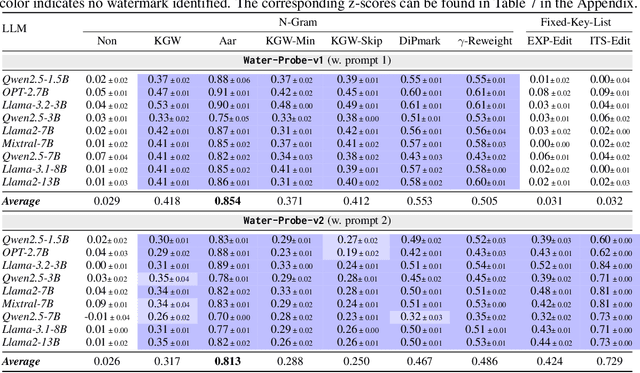


Abstract:Text watermarking for Large Language Models (LLMs) has made significant progress in detecting LLM outputs and preventing misuse. Current watermarking techniques offer high detectability, minimal impact on text quality, and robustness to text editing. However, current researches lack investigation into the imperceptibility of watermarking techniques in LLM services. This is crucial as LLM providers may not want to disclose the presence of watermarks in real-world scenarios, as it could reduce user willingness to use the service and make watermarks more vulnerable to attacks. This work is the first to investigate the imperceptibility of watermarked LLMs. We design an identification algorithm called Water-Probe that detects watermarks through well-designed prompts to the LLM. Our key motivation is that current watermarked LLMs expose consistent biases under the same watermark key, resulting in similar differences across prompts under different watermark keys. Experiments show that almost all mainstream watermarking algorithms are easily identified with our well-designed prompts, while Water-Probe demonstrates a minimal false positive rate for non-watermarked LLMs. Finally, we propose that the key to enhancing the imperceptibility of watermarked LLMs is to increase the randomness of watermark key selection. Based on this, we introduce the Water-Bag strategy, which significantly improves watermark imperceptibility by merging multiple watermark keys.
WaterSeeker: Efficient Detection of Watermarked Segments in Large Documents
Sep 08, 2024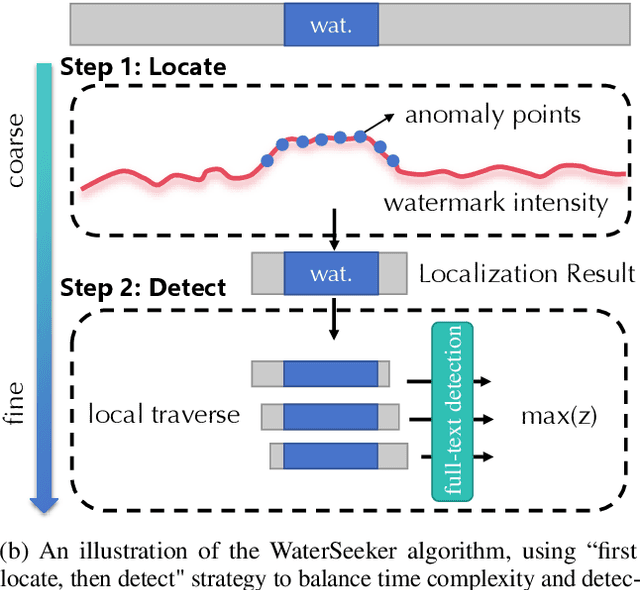
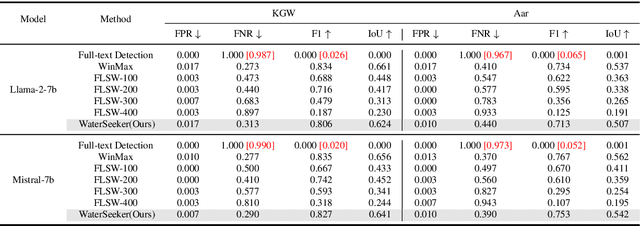


Abstract:Watermarking algorithms for large language models (LLMs) have attained high accuracy in detecting LLM-generated text. However, existing methods primarily focus on distinguishing fully watermarked text from non-watermarked text, overlooking real-world scenarios where LLMs generate only small sections within large documents. In this scenario, balancing time complexity and detection performance poses significant challenges. This paper presents WaterSeeker, a novel approach to efficiently detect and locate watermarked segments amid extensive natural text. It first applies an efficient anomaly extraction method to preliminarily locate suspicious watermarked regions. Following this, it conducts a local traversal and performs full-text detection for more precise verification. Theoretical analysis and experimental results demonstrate that WaterSeeker achieves a superior balance between detection accuracy and computational efficiency. Moreover, WaterSeeker's localization ability supports the development of interpretable AI detection systems. This work pioneers a new direction in watermarked segment detection, facilitating more reliable AI-generated content identification.
MarkLLM: An Open-Source Toolkit for LLM Watermarking
May 16, 2024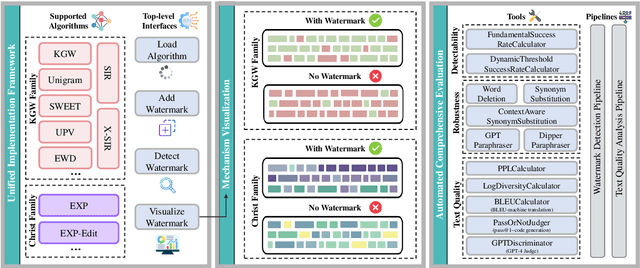
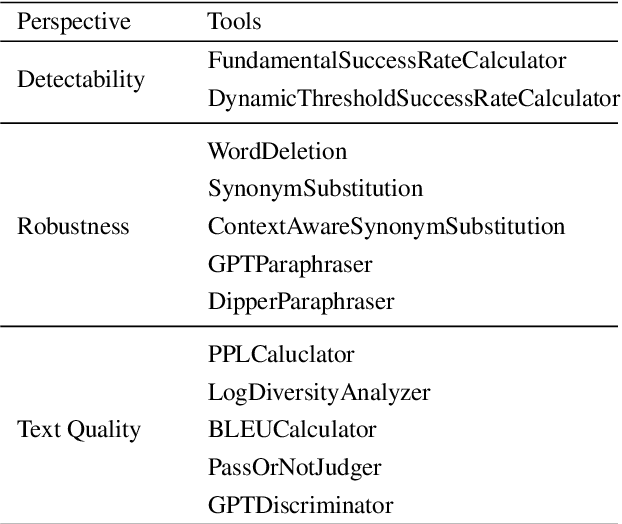
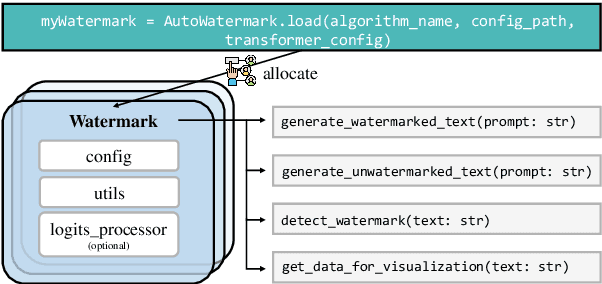
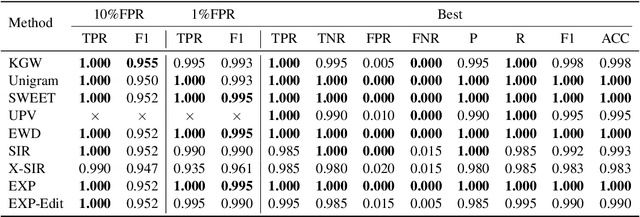
Abstract:LLM watermarking, which embeds imperceptible yet algorithmically detectable signals in model outputs to identify LLM-generated text, has become crucial in mitigating the potential misuse of large language models. However, the abundance of LLM watermarking algorithms, their intricate mechanisms, and the complex evaluation procedures and perspectives pose challenges for researchers and the community to easily experiment with, understand, and assess the latest advancements. To address these issues, we introduce MarkLLM, an open-source toolkit for LLM watermarking. MarkLLM offers a unified and extensible framework for implementing LLM watermarking algorithms, while providing user-friendly interfaces to ensure ease of access. Furthermore, it enhances understanding by supporting automatic visualization of the underlying mechanisms of these algorithms. For evaluation, MarkLLM offers a comprehensive suite of 12 tools spanning three perspectives, along with two types of automated evaluation pipelines. Through MarkLLM, we aim to support researchers while improving the comprehension and involvement of the general public in LLM watermarking technology, fostering consensus and driving further advancements in research and application. Our code is available at https://github.com/THU-BPM/MarkLLM.
A Survey of Text Watermarking in the Era of Large Language Models
Jan 03, 2024



Abstract:Text watermarking algorithms play a crucial role in the copyright protection of textual content, yet their capabilities and application scenarios have been limited historically. The recent developments in large language models (LLMs) have opened new opportunities for the advancement of text watermarking techniques. LLMs not only enhance the capabilities of text watermarking algorithms through their text understanding and generation abilities but also necessitate the use of text watermarking algorithms for their own copyright protection. This paper conducts a comprehensive survey of the current state of text watermarking technology, covering four main aspects: (1) an overview and comparison of different text watermarking techniques; (2) evaluation methods for text watermarking algorithms, including their success rates, impact on text quality, robustness, and unforgeability; (3) potential application scenarios for text watermarking technology; (4) current challenges and future directions for development. This survey aims to provide researchers with a thorough understanding of text watermarking technology, thereby promoting its further advancement.
A Semantic Invariant Robust Watermark for Large Language Models
Oct 10, 2023
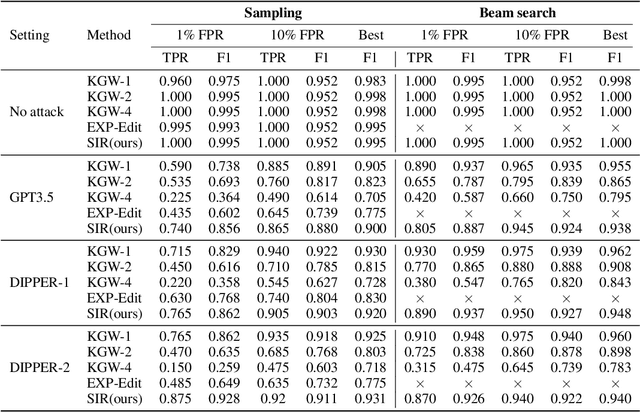
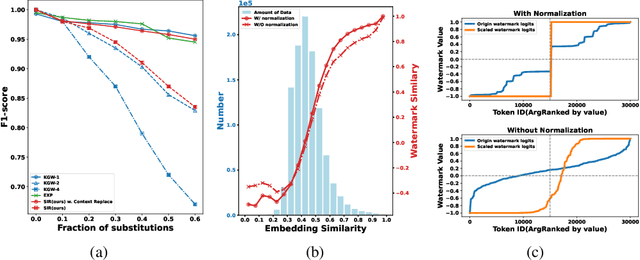

Abstract:Watermark algorithms for large language models (LLMs) have achieved extremely high accuracy in detecting text generated by LLMs. Such algorithms typically involve adding extra watermark logits to the LLM's logits at each generation step. However, prior algorithms face a trade-off between attack robustness and security robustness. This is because the watermark logits for a token are determined by a certain number of preceding tokens; a small number leads to low security robustness, while a large number results in insufficient attack robustness. In this work, we propose a semantic invariant watermarking method for LLMs that provides both attack robustness and security robustness. The watermark logits in our work are determined by the semantics of all preceding tokens. Specifically, we utilize another embedding LLM to generate semantic embeddings for all preceding tokens, and then these semantic embeddings are transformed into the watermark logits through our trained watermark model. Subsequent analyses and experiments demonstrated the attack robustness of our method in semantically invariant settings: synonym substitution and text paraphrasing settings. Finally, we also show that our watermark possesses adequate security robustness. Our code and data are available at https://github.com/THU-BPM/Robust_Watermark.
 Add to Chrome
Add to Chrome Add to Firefox
Add to Firefox Add to Edge
Add to Edge